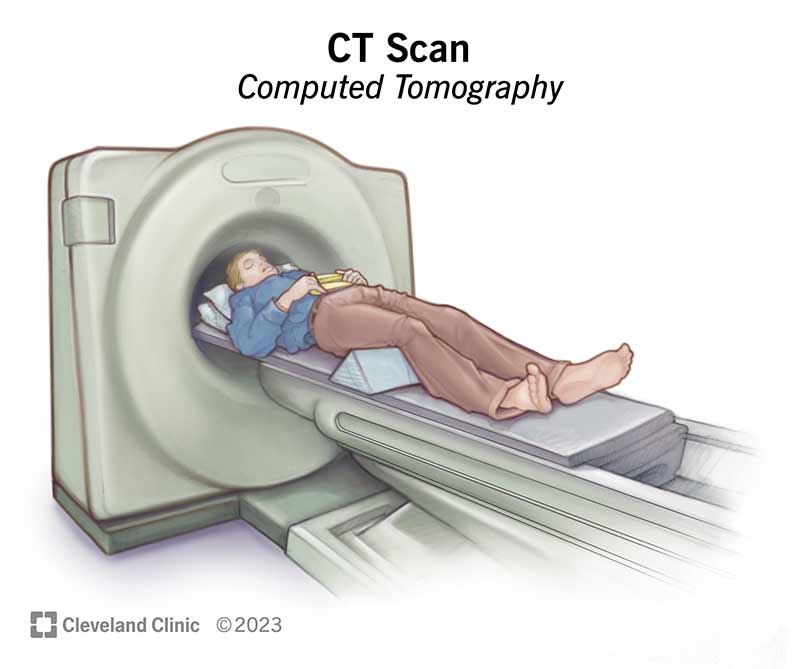A CT (computed tomography) scan is an imaging test that helps healthcare providers detect diseases and injuries. It uses a series of X-rays and a computer to create detailed images of your bones and soft tissues. A CT scan is painless and noninvasive. You might go to a hospital or imaging center for your CT scan.
Advertisement
Cleveland Clinic is a non-profit academic medical center. Advertising on our site helps support our mission. We do not endorse non-Cleveland Clinic products or services. Policy
A CT (computed tomography) scan is a type of imaging test. Like an X-ray, it shows structures inside your body. But instead of creating a flat, 2D image, a CT scan takes dozens to hundreds of images of your body. To get these images, a CT machine takes X-ray pictures as it revolves around you.
Advertisement
Cleveland Clinic is a non-profit academic medical center. Advertising on our site helps support our mission. We do not endorse non-Cleveland Clinic products or services. Policy
Healthcare providers use CT scans to see things that regular X-rays can’t show. For example, body structures overlap on regular X-rays and many things aren’t visible. A CT shows the details of each of your organs for a clearer and more precise view.
Another term for CT scan is CAT scan. CT stands for “computed tomography,” while CAT stands for “computed axial tomography.” But these two terms describe the same imaging test.
A CT scan takes pictures of your:
CT scans help healthcare providers detect various injuries and diseases, including:

Your healthcare provider will tell you everything you need to know about CT scan preparation. Here are some general guidelines:
Advertisement
Your provider might use a contrast material to highlight certain areas of your body on the scan. For a CT scan with contrast, your provider will place an IV (intravenous line) and inject a contrast (or dye) into your vein. They may also give you a substance to drink (like a barium swallow) to highlight your intestines. Both improve the visibility of specific tissues, organs or blood vessels and help healthcare providers diagnose several medical conditions. IV contrast agents usually flush from your system (when you pee) within 24 hours.
Here are some additional preparation guidelines for a CT scan with contrast:
During the test, you’ll usually lie on your back on a table (like a bed). If your test requires it, a healthcare provider may inject the contrast dye intravenously (into your vein). This dye can make you feel flushed or give you a metallic taste in your mouth.
When the scan begins:
CT scans usually take about an hour. Most of that time is for the preparation. The scan itself takes fewer than 10 or 15 minutes. You can resume normal activities after your provider gives you the OK — usually after they complete the scan and make sure the images are of good quality.
CT scans themselves usually don’t cause side effects. But some people develop minor side effects from contrast material. These side effects may include:
Advertisement
It usually takes about 24 to 48 hours to get the results of your CT scan. A radiologist (a physician who specializes in reading and interpreting CT scans and other radiologic exams) will review your scan and prepare a report that explains the findings. In an emergency setting, like a hospital or emergency room, healthcare providers often receive results within an hour.
Once a radiologist and your healthcare provider have reviewed the results, you’ll either have another appointment or receive a call. Your healthcare provider will discuss the results with you.
Healthcare providers consider CT scans generally safe. CT scans for children are safe, too. For children, your provider adjusts to a lower dose to reduce their radiation exposure.
Like X-rays, CT scans use a small amount of ionizing radiation to capture images. Possible risks of radiation include:
If you have concerns about the health risks of CT scans, talk to your healthcare provider. They’ll help you make an informed decision about the scan.
Advertisement
If you’re pregnant or think you might be pregnant, you should tell your provider. CT scans of your pelvis and abdomen can expose the developing fetus to radiation, but it’s not enough to cause harm. CT scans in other parts of your body don’t put the fetus at any risk.
A note from Cleveland Clinic
It’s normal to have questions or feel a little worried if your provider recommends a CT (computed tomography) scan. But CT scans themselves are painless, carry very little risk and can help providers detect a wide range of health conditions. Getting an accurate diagnosis also helps your healthcare provider determine the best treatment for your situation. Talk to them about any concerns you have, including other options for testing.
Advertisement
Last reviewed on 06/13/2023.
Learn more about the Health Library and our editorial process.